+ Open data
Open data
- Basic information
Basic information
| Entry | Database: PDB / ID: 3fgw | |||||||||
|---|---|---|---|---|---|---|---|---|---|---|
| Title | One chain form of the 66.3 kDa protein | |||||||||
 Components Components | Putative phospholipase B-like 2 | |||||||||
 Keywords Keywords |  HYDROLASE / alpha beta / HYDROLASE / alpha beta /  glycosylated / glycosylated /  disulphide bonds / N-terminal hydrolase fold / occupied pocket / one chain form / disulphide bonds / N-terminal hydrolase fold / occupied pocket / one chain form /  Glycoprotein / Lipid degradation / Glycoprotein / Lipid degradation /  Lysosome Lysosome | |||||||||
| Function / homology |  Function and homology information Function and homology information phospholipase activity / phospholipid catabolic process / phospholipase activity / phospholipid catabolic process /  Hydrolases; Acting on ester bonds; Carboxylic-ester hydrolases / lysosomal lumen / Hydrolases; Acting on ester bonds; Carboxylic-ester hydrolases / lysosomal lumen /  lysosome / extracellular region lysosome / extracellular regionSimilarity search - Function | |||||||||
| Biological species |   Mus musculus (house mouse) Mus musculus (house mouse) | |||||||||
| Method |  X-RAY DIFFRACTION / X-RAY DIFFRACTION /  SYNCHROTRON / SYNCHROTRON /  MOLECULAR REPLACEMENT / MOLECULAR REPLACEMENT /  molecular replacement / Resolution: 2.8 Å molecular replacement / Resolution: 2.8 Å | |||||||||
 Authors Authors | Lakomek, K. / Dickmanns, A. / Ficner, R. | |||||||||
 Citation Citation |  Journal: Bmc Struct.Biol. / Year: 2009 Journal: Bmc Struct.Biol. / Year: 2009Title: Initial insight into the function of the lysosomal 66.3 kDa protein from mouse by means of X-ray crystallography Authors: Lakomek, K. / Dickmanns, A. / Kettwig, M. / Urlaub, H. / Ficner, R. / Luebke, T. #1:  Journal: Acta Crystallogr.,Sect.D / Year: 2009 Journal: Acta Crystallogr.,Sect.D / Year: 2009Title: De novo sulfur SAD phasing of the lysosomal 66.3 kDa protein from mouse Authors: Lakomek, K. / Dickmanns, A. / Mueller, U. / Kollmann, K. / Deuschl, F. / Berndt, A. / Luebke, T. / Ficner, R. | |||||||||
| History |
|
- Structure visualization
Structure visualization
| Structure viewer | Molecule:  Molmil Molmil Jmol/JSmol Jmol/JSmol |
|---|
- Downloads & links
Downloads & links
- Download
Download
| PDBx/mmCIF format |  3fgw.cif.gz 3fgw.cif.gz | 127.9 KB | Display |  PDBx/mmCIF format PDBx/mmCIF format |
|---|---|---|---|---|
| PDB format |  pdb3fgw.ent.gz pdb3fgw.ent.gz | 95.8 KB | Display |  PDB format PDB format |
| PDBx/mmJSON format |  3fgw.json.gz 3fgw.json.gz | Tree view |  PDBx/mmJSON format PDBx/mmJSON format | |
| Others |  Other downloads Other downloads |
-Validation report
| Arichive directory |  https://data.pdbj.org/pub/pdb/validation_reports/fg/3fgw https://data.pdbj.org/pub/pdb/validation_reports/fg/3fgw ftp://data.pdbj.org/pub/pdb/validation_reports/fg/3fgw ftp://data.pdbj.org/pub/pdb/validation_reports/fg/3fgw | HTTPS FTP |
|---|
-Related structure data
| Related structure data | 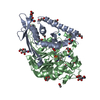 3fgrC 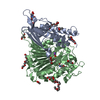 3fgtC  3fbxS S: Starting model for refinement C: citing same article ( |
|---|---|
| Similar structure data |
- Links
Links
- Assembly
Assembly
| Deposited unit | 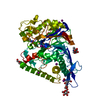
| ||||||||
|---|---|---|---|---|---|---|---|---|---|
| 1 | 
| ||||||||
| Unit cell |
| ||||||||
| Details | author states that the biological unit is unknown |
- Components
Components
-Protein , 1 types, 1 molecules A
| #1: Protein | Mass: 63185.285 Da / Num. of mol.: 1 Source method: isolated from a genetically manipulated source Source: (gene. exp.)   Mus musculus (house mouse) / Strain: C3H/RV / Gene: AAG44101 / Plasmid: pcDNA3.1/Hygro(+) / Cell (production host): fibrosarcoma cell / Cell line (production host): HT1080 / Production host: Mus musculus (house mouse) / Strain: C3H/RV / Gene: AAG44101 / Plasmid: pcDNA3.1/Hygro(+) / Cell (production host): fibrosarcoma cell / Cell line (production host): HT1080 / Production host:   Homo sapiens (human) Homo sapiens (human)References: UniProt: Q3TCN2,  Hydrolases; Acting on ester bonds; Carboxylic-ester hydrolases Hydrolases; Acting on ester bonds; Carboxylic-ester hydrolases |
|---|
-Sugars , 2 types, 4 molecules 
| #2: Polysaccharide | beta-D-mannopyranose-(1-4)-2-acetamido-2-deoxy-beta-D-glucopyranose-(1-4)-2-acetamido-2-deoxy-beta- ...beta-D-mannopyranose-(1-4)-2-acetamido-2-deoxy-beta-D-glucopyranose-(1-4)-2-acetamido-2-deoxy-beta-D-glucopyranose / Mass: 586.542 Da / Num. of mol.: 1 / Mass: 586.542 Da / Num. of mol.: 1Source method: isolated from a genetically manipulated source |
|---|---|
| #3: Sugar |  N-Acetylglucosamine N-Acetylglucosamine |
-Non-polymers , 4 types, 171 molecules 






| #4: Chemical |  Glycerol Glycerol#5: Chemical | ChemComp-IOD /  Iodide Iodide#6: Chemical | ChemComp-NA / | #7: Water | ChemComp-HOH / |  Water Water |
|---|
-Experimental details
-Experiment
| Experiment | Method:  X-RAY DIFFRACTION / Number of used crystals: 1 X-RAY DIFFRACTION / Number of used crystals: 1 |
|---|
- Sample preparation
Sample preparation
| Crystal | Density Matthews: 3.54 Å3/Da / Density % sol: 65.3 % |
|---|---|
Crystal grow | Temperature: 293 K / Method: vapor diffusion, sitting drop / pH: 4.6 Details: 12% (w/v) PEG 4000, 100mM NH4Ac, 100mM NaAc/HAc pH 4.6, VAPOR DIFFUSION, SITTING DROP, temperature 293K |
-Data collection
| Diffraction | Mean temperature: 100 K |
|---|---|
| Diffraction source | Source:  SYNCHROTRON / Site: SYNCHROTRON / Site:  BESSY BESSY  / Beamline: 14.1 / Wavelength: 1.8 Å / Beamline: 14.1 / Wavelength: 1.8 Å |
| Detector | Type: MARMOSAIC 325 mm CCD / Detector: CCD / Date: Feb 5, 2008 |
| Radiation | Protocol: SINGLE WAVELENGTH / Monochromatic (M) / Laue (L): M / Scattering type: x-ray |
| Radiation wavelength | Wavelength : 1.8 Å / Relative weight: 1 : 1.8 Å / Relative weight: 1 |
| Reflection | Resolution: 2.8→46.07 Å / Num. obs: 21117 / % possible obs: 97.2 % / Observed criterion σ(I): 6 / Redundancy: 3 % / Rmerge(I) obs: 0.139 / Rsym value: 0.139 / Net I/σ(I): 5.6 |
| Reflection shell | Resolution: 2.8→2.95 Å / Redundancy: 3 % / Rmerge(I) obs: 0.43 / Mean I/σ(I) obs: 2 / Rsym value: 0.43 / % possible all: 96.2 |
-Phasing
Phasing | Method:  molecular replacement molecular replacement |
|---|
- Processing
Processing
| Software |
| ||||||||||||||||||||||||||||||||||||||||||||||||||||||||||||||||||||||
|---|---|---|---|---|---|---|---|---|---|---|---|---|---|---|---|---|---|---|---|---|---|---|---|---|---|---|---|---|---|---|---|---|---|---|---|---|---|---|---|---|---|---|---|---|---|---|---|---|---|---|---|---|---|---|---|---|---|---|---|---|---|---|---|---|---|---|---|---|---|---|---|
| Refinement | Method to determine structure : :  MOLECULAR REPLACEMENT MOLECULAR REPLACEMENTStarting model: PDB ENTRY 3FBX Resolution: 2.8→46.07 Å / Cor.coef. Fo:Fc: 0.908 / Cor.coef. Fo:Fc free: 0.877 / WRfactor Rfree: 0.253 / WRfactor Rwork: 0.224 / Occupancy max: 1 / Occupancy min: 0.5 / FOM work R set: 0.855 / SU B: 11.5 / SU ML: 0.227 / SU R Cruickshank DPI: 0.539 / SU Rfree: 0.342 / Cross valid method: THROUGHOUT / σ(F): 0 / ESU R: 0.539 / ESU R Free: 0.342 / Stereochemistry target values: MAXIMUM LIKELIHOOD Details: HYDROGENS HAVE BEEN ADDED IN THE RIDING POSITIONS; CNS 1.21 was also used in refinement
| ||||||||||||||||||||||||||||||||||||||||||||||||||||||||||||||||||||||
| Solvent computation | Ion probe radii: 0.8 Å / Shrinkage radii: 0.8 Å / VDW probe radii: 1.2 Å / Solvent model: MASK | ||||||||||||||||||||||||||||||||||||||||||||||||||||||||||||||||||||||
| Displacement parameters | Biso max: 95.21 Å2 / Biso mean: 32.212 Å2 / Biso min: 2 Å2
| ||||||||||||||||||||||||||||||||||||||||||||||||||||||||||||||||||||||
| Refinement step | Cycle: LAST / Resolution: 2.8→46.07 Å
| ||||||||||||||||||||||||||||||||||||||||||||||||||||||||||||||||||||||
| Refine LS restraints |
| ||||||||||||||||||||||||||||||||||||||||||||||||||||||||||||||||||||||
| LS refinement shell | Resolution: 2.8→2.873 Å / Total num. of bins used: 20
|
 Movie
Movie Controller
Controller








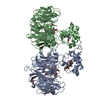



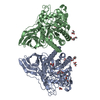
 PDBj
PDBj



